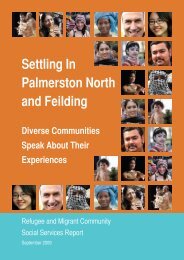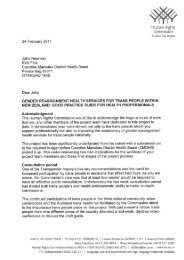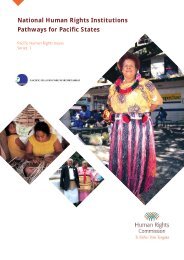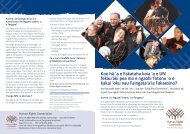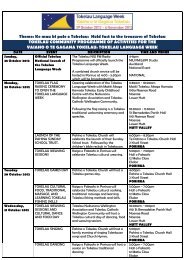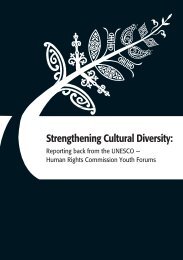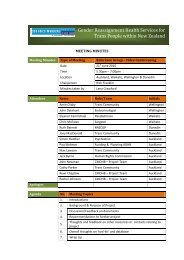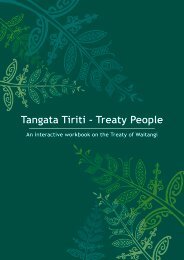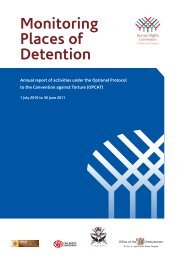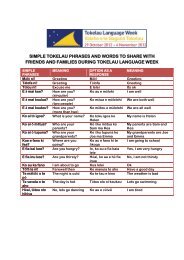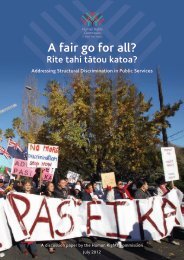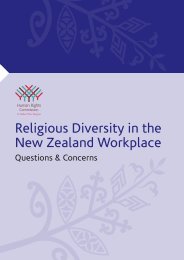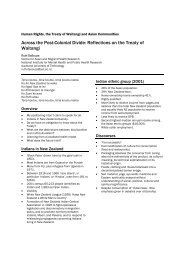16. Rights of Children and Young People - Human Rights Commission
16. Rights of Children and Young People - Human Rights Commission
16. Rights of Children and Young People - Human Rights Commission
You also want an ePaper? Increase the reach of your titles
YUMPU automatically turns print PDFs into web optimized ePapers that Google loves.
250<br />
SECTION FOUR – RIGHTS OF SPECIFIC GROUPS<br />
Over the past two decades, children have consistently<br />
been the age group most likely to live in low-income<br />
households, crowded households <strong>and</strong> households experiencing<br />
material hardship or deprivation. 56 57<br />
In recent years, child poverty rates 58 have declined, from<br />
26 per cent in 2004 to 22 per cent in 2008. 59 Levels <strong>of</strong><br />
hardship suffered by children have also improved, falling<br />
from 26 per cent in 2004 to 19 per cent in 2008.<br />
The Working for Families package has had a significant<br />
effect on poverty rates for families with an adult in paid<br />
work. 60 This policy has also enabled some parents <strong>and</strong><br />
caregivers to move into employment. However, benefitdependent<br />
families not entitled to receive the In Work<br />
Tax Credit component <strong>of</strong> Working for Families have not<br />
seen the same gains. Poverty rates are higher for children<br />
in benefit-dependent households, 61 <strong>and</strong> beneficiary<br />
families with dependent children have a hardship rate<br />
more than five times that <strong>of</strong> working families with<br />
children. 62<br />
In 2008, the claim brought by the Child Poverty Action<br />
Group (CPAG) was heard by the <strong>Human</strong> <strong>Rights</strong> Review<br />
Tribunal. CPAG argued that the In Work Tax Credit in<br />
the Working for Families scheme discriminated against<br />
the children <strong>of</strong> beneficiaries on the grounds <strong>of</strong> their<br />
employment status. The tribunal’s decision found a prima<br />
facie case <strong>of</strong> discrimination, but said it was “justified in a<br />
free <strong>and</strong> democratic society”. 63<br />
Child poverty is unevenly distributed across society,<br />
particularly affecting sole-parent families, families with<br />
no adult in full-time work, Mäori <strong>and</strong> Pacific peoples <strong>and</strong><br />
disabled children. 64 Disparities between different groups<br />
are marked. In 2003–04, 16 per cent <strong>of</strong> Päkehä children<br />
lived in poverty, compared with 27 per cent <strong>of</strong> Mäori<br />
children <strong>and</strong> 40 per cent <strong>of</strong> Pacific <strong>and</strong> ‘Other’ children.<br />
Ethnicity breakdowns <strong>of</strong> child poverty data are no longer<br />
reported, because low sample sizes raise concern about<br />
data quality. 65 This severely limits the ability to monitor<br />
the number <strong>and</strong> proportion <strong>of</strong> Mäori or Pacific children<br />
living in poverty. Mäori <strong>and</strong> Pacific families are also more<br />
likely to be living in overcrowded homes (32 per cent <strong>and</strong><br />
37 per cent respectively, compared with 10 per cent <strong>of</strong><br />
the general population). 66 <strong>Children</strong> in poor families are<br />
more likely to be sick <strong>and</strong> injured, they are at greater risk<br />
<strong>of</strong> abuse <strong>and</strong> neglect, <strong>and</strong> their educational achievement<br />
<strong>and</strong> subsequent employment opportunities are affected as<br />
a result. 67<br />
In 2009, the OECD reported that in recent years 68 New<br />
Zeal<strong>and</strong> spent less than the OECD average on young<br />
children in particular, even though spending more on<br />
young children is more likely to generate positive changes<br />
<strong>and</strong> make a difference in the long term. 69 Based on international<br />
evidence, the OECD concluded that New Zeal<strong>and</strong><br />
should spend considerably more on younger, disadvantaged<br />
children, <strong>and</strong> should ensure that current rates <strong>of</strong><br />
spending on older children are more effective in meeting<br />
the needs <strong>of</strong> the disadvantaged among them.<br />
56 Ministry <strong>of</strong> Social Development (2009), Social Report 2009 (Wellington: MSD), pp 63–66<br />
57 Perry B (December 2009)<br />
58 Using the measure <strong>of</strong> 60 per cent <strong>of</strong> median income, before housing costs.<br />
59 Perry B (December 2009)<br />
60 Perry B (June 2009)<br />
61 ibid. p 98<br />
62 Perry B (December 2009), p 53<br />
63 Child Poverty Action Group v Attorney General [2008] NZHRRT 31<br />
64 Fletcher M <strong>and</strong> Dwyer M (2001), A Fair Go for all <strong>Children</strong>: Actions to address child poverty in New Zeal<strong>and</strong>, A Report for the <strong>Children</strong>’s<br />
<strong>Commission</strong>er (Wellington: OCC)<br />
65 ibid. p 25; Ministry <strong>of</strong> Social Development (2009), Social Report 2009, p 161<br />
66 Ministry <strong>of</strong> Social Development (2009), Social Report 2009, p 67<br />
67 Fletcher M <strong>and</strong> Dwyer M (2001)<br />
68 The OECD report does not fully reflect the impact <strong>of</strong> the Working For Families package<br />
69 Organisation for Economic Co-operation <strong>and</strong> Development (2009)



